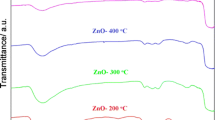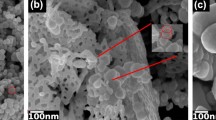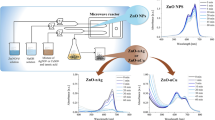Abstract
Microwave hydrothermal synthesis, using an experimental 23 factorial design, was used to produce tunable ZnO nano- and microstructures, and their potential as photocatalysts was explored. Photocatalytic reactions were conducted in a microreactor batch system under UV and visible light irradiation, while monitoring methylene blue degradation, as a model system. The variables considered in the microwave reactor to produce ZnO nano- or microstructures, were time, NaOH concentration and synthesis temperature. It was found that, specific surface area and volume/surface area ratio were affected as a consequence of the synthesis conditions. In the second stage, the samples were plasma treated in a nitrogen atmosphere, with the purpose of introducing nitrogen into the ZnO crystalline structure. The central idea is to induce changes in the material structure as well as in its optical absorption, to make the plasma-treated material useful as photocatalyst in the visible region of the electromagnetic spectrum. Pristine ZnO and nitrogen-doped ZnO compounds were characterized by means of X-ray diffraction (XRD), scanning electron microscopy (SEM), specific surface area (BET), XPS, and UV–Vis diffuse reflectance spectroscopy. The results show that the methodology presented in this work is effective in tailoring the specific surface area of the ZnO compounds and incorporation of nitrogen into their structure, factors which in turn, affect its photocatalytic behavior.






Similar content being viewed by others
References
F. Abdullah, M. Rauf, S. Ashraf, Photolytic oxidation of Safranin-O with H2O2. Dyes Pigm. 72, 349–352 (2007)
W. Baran, E. Adamek, A. Makowski, The influence of selected parameters on the photocatalytic degradation of azo-dyes in the presence of TiO2 aqueous suspension. Chem. Eng. J. 145, 242–248 (2008)
C. Fernández, M.S. Larrechi, M.P. Callao, An analytical overview of processes for removing organic dyes from wastewater effluents. Trends Anal. Chem. 29, 1202–1211 (2010)
L. Liu, C. Dong, K.L. Wu, Y. Ye, W. Wei, Synthesis of nitrogen-doped graphene–ZnO nanocomposites with improved photocatalytic activity. Mater. Lett. 129, 170–173 (2014)
H. Qin, W. Li, Y. Xia, T. He, Photocatalytic activity of heterostructures based on ZnO and N-doped ZnO. ACS Appl. Mater. Interfaces. 3, 3152–3156 (2011)
M.C. Yeber, J. Rodríguez, J. Freer, N. Durán, H.D. Mansilla, Photocatalytic degradation of cellulose bleaching effluent by supported TiO2 and ZnO. Chemosphere 41, 1193–1197 (2000)
S.K. Kansal, M. Singh, D. Sud, Studies on TiO2/ZnO photocatalysed degradation of lignin. J. Hazard. Mater. 153, 412–417 (2000)
N. Daneshvar, D. Salari, A.R. Kataee, Photocatalytic degradation of azo dye acid red 14 in water on ZnO as an alternative catalyst to TiO2. J. Photochem. Photobiol. A Chem. 162, 317–322 (2004)
M. Gancheva, M. Markova-Velichkova, G. Atanasova, D. Kovacheva, I. Uzunov, R. Cukeva, Design and photocatalytic activity of nanosized zinc oxides. Appl. Surf. Sci. 368, 258–266 (2016)
R. Rangel, J.D. García-Espinoza, I. Espitia-Cabrera, J.J. Alvarado-Gil, P. Quintana, P. Bartolo-Pérez, R. Trejo-Tzab, Synthesis of mesoporous of NyTi1−xCexO2−y structures and its visible light induced photocatalytic performance. NANO 1, 1350051–1350061 (2013)
H. Sun, H. Wang, M. Ang, Q. Tadé, Halogen element modified titanium dioxide for visible light photocatalysis. Chem. Eng. J. 162, 437–447 (2010)
J.M. Herrmann, Fundamentals and misconceptions in photocatalysis. J. Photochem. Photobiol. A Chem. 216, 85–93 (2010)
J.M. Herrmann, Photocatalysis fundamentals revisited to avoid several misconceptions. Top. Catal. 39, 461–468 (2006)
A. Mukherji, B. Seger, G. Qing (Max) Lu, L. Lu, ACS Nano 5, 3483–3492 (2011)
A.M. Ferrari-Lima, R.P. de Souza, S.S. Mendes, R.G. Marques, M.L. Gimenes, N.R.C. Fernandes-Machado, Photodegradation of benzene, toluene and xylenes under visible light applying N-doped mixed TiO2 and ZnO. Catal. Today 241, 40–46 (2015)
A. Weibel, R. Bouchet, F. Boulc’h, P. Knauth, The big problem of small particles: a comparison of methods for determination of particle size in nanocrystalline anatase powders. Chem. Mater. 17, 2378–2385 (2005)
J. Janata, Principles of chemical sensors, 2nd edn. (Springer, New York, 2009), pp. 284–285
A. Escobedo, E. Sanchez, U. Pal, Use of diffuse reflectance spectroscopy for optical characterization of un-supported nanostructures. Rev. Mex. Fis. 53, 18–22 (2007)
X. Zhou, F. Peng, H. Wang, H. Yu, Y. Fang, A simple preparation of nitrogen doped titanium dioxide nanocrystals with exposed (001) facets with high visible light activity. Chem. Commun. 48, 600–602 (2012)
S. Xu, N. Adiga, S. Ba, T. Dasgupta, C.F. Jeff Wu, Z.L. Wang, Optimizing and improving the growth quality of ZnO nanowire arrays guided by statistical design of experiments. ACS Nano 3, 1803–1812 (2009)
N.R. Yogamalar, ACh. Bose, Synthesis, dopant study and device fabrication of zinc oxide nanostructures: mini review. Prog. Nanotechnol. Nanomater. 2, 25–44 (2013)
Acknowledgements
R. Rangel acknowledges CIC-UMSNH under project 2017. R. Gutiérrez acknowledges a postdoctoral fellowship from Conacyt. P. Quintana acknowledges financial support provided through projects FOMIX-YUC No. 108160 and LANNBIO 123913 CONACyT. Authors wish to thank the technical help provided by D. Aguilar (DRX), W. Cauich (XPS), D. Huerta (SEM), J. Bante, B. Heredia and D. Macías for their support to obtain the reflectance measurements. R. Rangel acknowledges the support of the Red de Energía Solar.
Author information
Authors and Affiliations
Corresponding author
Rights and permissions
About this article
Cite this article
Rangel, R., Cedeño, V., Ramos-Corona, A. et al. Tailoring surface and photocatalytic properties of ZnO and nitrogen-doped ZnO nanostructures using microwave-assisted facile hydrothermal synthesis. Appl. Phys. A 123, 552 (2017). https://doi.org/10.1007/s00339-017-1137-5
Received:
Accepted:
Published:
DOI: https://doi.org/10.1007/s00339-017-1137-5




